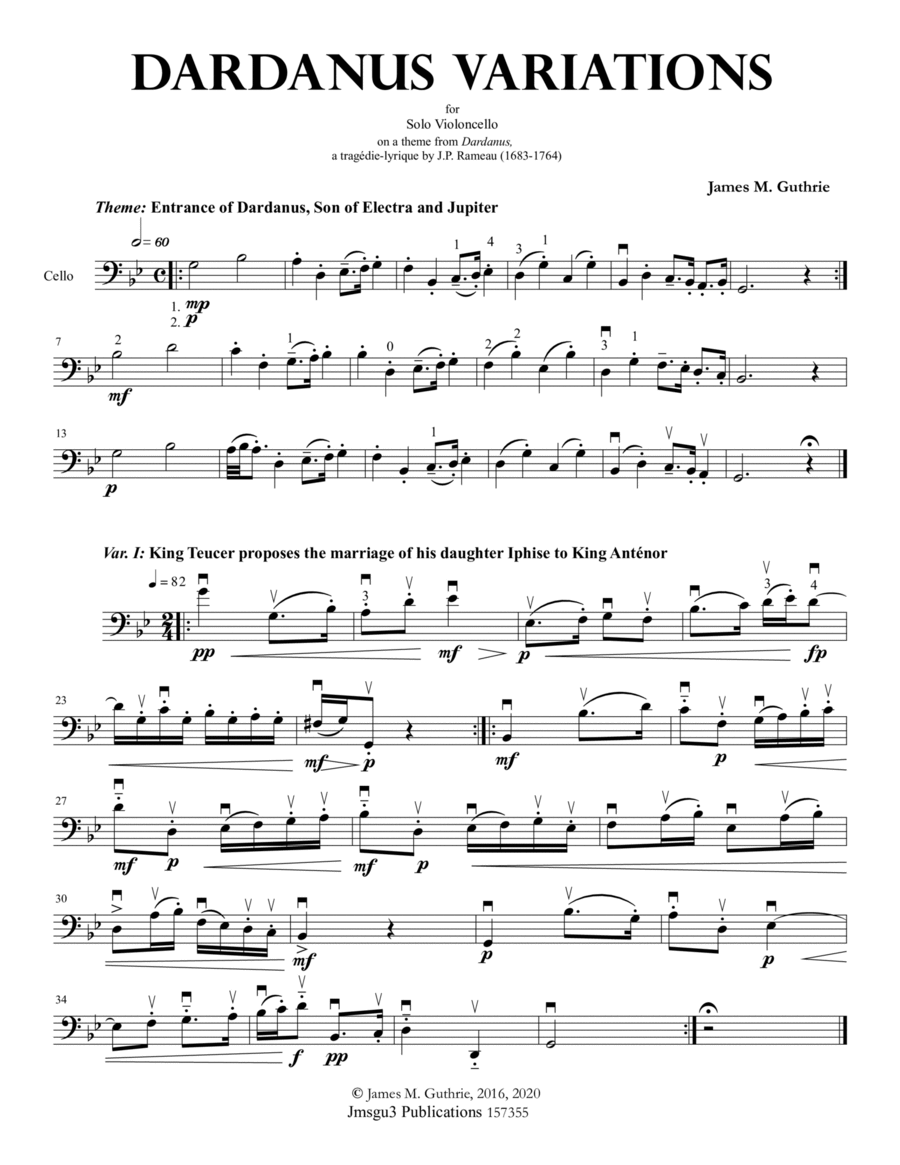Cello Solo - Level 4 - Digital Download SKU: A0.547674 Composed by James M. Guthrie. Contemporary,Instructional. Individual part. 9 pages. Jmsgu3 #3031709. Published by jmsgu3 (A0.547674). Dardanus Variations for Solo Cello is a set of variations on a thematic fragment from Dardanus, a tragédie-lyrique by J.P. Rameau (1683-1764). Each variation depicts a different scene from the opera.I: Entrance of Dardanus: Son of Electra and JupiterII: King Teucer proposes the marriage of his daughter Iphise to King AnténorIII: King Anténor accepts Iphise to become his brideIV: Ismenor the Wizard introduces Iphise to DardanusV: Dardanus encounters the sea monsterVI: The Sea Monster creates havoc for King AnténorVII: Dardanus falls in love with IphiseVIII: Dardanus slays the Sea Monster, saving King Anténor's lifeIX: King Teucer and Dardanus make peaceX: King Teucer permits for Dardanus to marry IphiseXI: The Proposal of DardanusXII: Iphise rejects the proposalXIII: The Second Proposal of DardanusIXV: Wedding Dance Dardanus is connected to the Trojan War through his lineage and the founding of the royal house of Troy. The Dardanoi, the descendants of Dardanus, formed a contingent among Troy's allies in the Trojan War. The House of Dardanus, of which Dardanus was the founder, played a significant role in the lead-up to the war. The city of Troy, founded by Dardanus's descendant, Ilus, was central to the myths surrounding the Trojan War. Additionally, Aeneas, a prominent figure in the Trojan War, was referred to as a Dardanian and was destined to save the House of Dardanus from extinction. Therefore, Dardanus's lineage and the founding of Troy are the critical connections between Dardanus and the Trojan War.Ancestry and Founder: Dardanus was the son of Zeus and the Pleiad Electra. He was the mythical founder of Dardania on the Hellespont and the ancestor of the Dardanians of the Troad and, through Aeneas, of the Romans.Migration and Settlement: According to mythology, Dardanus fled from Arcadia to the island of Samothrace and then to the Troad, where Teucer, the ruler of Phrygia, hospitably received him. He married Teucer's daughter Bateia and became the founder of the royal house of Troy.Family and Descendants: Dardanus married Chryse, with whom he fathered two sons, Idaeus and Deimas. He later married Batea and had several children, including Erichthonius, who became the ancestor of many famous individuals in the Troad, including Tros, Ganymede, Laomedon, and Priam.Cultural Depictions: Dardanus has been the subject of various operas by composers such as Jean-Philippe Rameau, Carl Stamitz, and Antonio Sacchini, reflecting the enduring influence of his mythological story.Legacy: Dardanus lives on in the Dardanelles, the narrow strait separating Asia and Europe, once known as the Hellespont, a name also linked to Greek mythology.These facts highlight Dardanus's role as a critical figure in the foundation of Dardania and the royal house of Troy and his rich and enduring mythological legacy.
